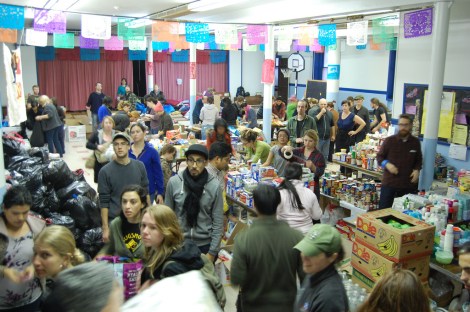It’s been nearly two weeks since Hurricane Sandy decimated large parts of the Eastern seaboard. The subway may be back, but more than a half million people are still without power and thousands are still without water. The conversation continues about how best to adapt to a new world of monster weather.

Jeremy ZilarAn Occupy Sandy distribution center in Sunset Park, Brooklyn.
Scientific American has an interview today with climate scientist Cynthia Rosenzweig, who has been studying the impact of climate change on New York since the ’90s, and first analyzed risks to the city infrastructure from rising waters in 2001. Rosenzweig says a new way forward for coastal communities will require “an integrated approach that covers three areas: engineering, ecologically based adaptation and policies.”
Overarching all of this is design, urban planning. What we really need to do is recover, rebuild and create a vibrant and sustainable coastal city region. Let’s do this in creative ways. For example, the Dutch are not just looking to engineering solutions, they are looking at a mix of solutions. So there are the iconic floating houses but they are also doing a lot with raising apartment buildings and allowing water to slosh in and out when floods come. We have to accept that we are a coastal region. There are going to be coastal floods. How do we live with it?
How do we live with it? The Census has this great and kind of shocking visualization of how Americans are drawn to coastlines like moths to flame. That “we” is huge, and climate change will touch all of us.
We haven’t been able to look to the government for leadership on climate change, so why would we look to it for leadership on cleaning up the mess that climate change creates? In an interview at Salon, disaster historian and New York resident Jacob Remes discusses what “living with it” would look like from the ground up.
The best disaster relief is offered through solidarity, horizontally, through organizations that people are already members of. Sometimes that’s government. Often it’s not. Neoliberalism tries to dismantle government, but at the same time it creates this dynamic where all of the private interactions we have are economic exchanges. And that’s just as bad, especially in disaster relief.
Alison Kilkenny at The Nation reports on poor residents unable to afford the cleanup crews their rich neighbors have hired, while grassroots community efforts have been disorganized, if well-meaning.
That disorganization is to be expected — this stuff is pretty new. It’s also pretty effective. Kilkenny points to Occupy Sandy in particular. While public housing around the city is still without water and power, Occupy Sandy volunteers are knocking on doors in Rockaway high-rises and delivering supplies in Staten Island.
From The Nation:
Occupy believes what’s needed post-Sandy is solidarity, not charity. Charity implies an almost superficial, short-term Band-Aid solution when what’s really needed is a serious long-term effort to bring communities together, not just during the month-long frenzy inspired by a disaster, but all the time in order to develop solutions that work for everyone instead of just the 1 percent.
Grassroots aid efforts like Occupy Sandy aren’t perfect, but when FEMA and the Red Cross and the NYPD and the military fail to bring comfort and assistance to the communities of New York, Occupy attempted to fill the void, and for that, they should be commended.
Occupy Sandy has (as of right now) raised upwards of $371,000 to do this work, and drawn supplies and volunteers from far, far beyond any network Occupy Wall Street had created in New York over the past year. It’s hardly the only grassroots effort on the East Coast bringing relief to the Sandy-striken, but it’s representative of a larger shift in how we might “live with it” — a shift from charity to mutual aid and community connection.
That shift empowers individuals to “be the change,” to be active players in our shared fate and all the water it will bring to our shared cities. Sarah Goodyear at Atlantic Cities touches on this when she writes about the role of bikes in disaster response and recovery. You won’t need the National Guard to tow your bike, and you won’t need to stand in line for gas to power it. You can even keep riding as the flood waters rise. Here’s Goodyear:
New Yorkers are learning things from this storm, and from the relief efforts that are ongoing even as another weather front sweeps through …, forcing another round of evacuations. Practical things. They are learning where to go for help, and how to help each other. They are learning how to get around when the transportation system fails, and the importance of redundancy and resiliency in all kinds of infrastructure. They are learning what you really need to have on hand when supply chains are disrupted, and what you can do without. They are learning how to assess the accuracy of information, and how to spread it. They are learning that individual efforts, pooled together, can make a substantial material difference in a crisis.
Bicycles are part of all this. In the early days after the storm, when the trains and buses stopped running, bikes were one of the few reliable ways of moving people, objects, and information around streets choked with debris.
We live with crisis now — we may be post-Sandy, but we’re pre-Next-Sandy. The only way we’ll have any chance of reversing the course we’re on is by giving a shit about each other and our shared fate. And by riding bikes. As Sarah Jaffe wrote at Jacobin: “Because political organizing and mutual aid go hand in hand, or they should.”



